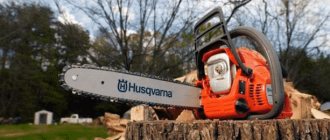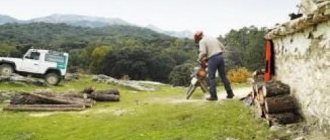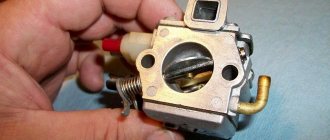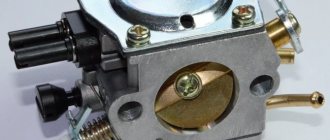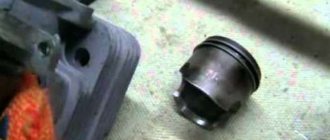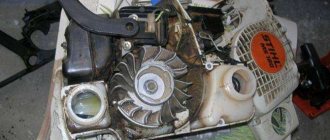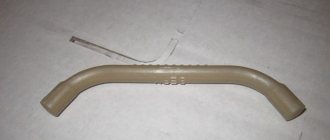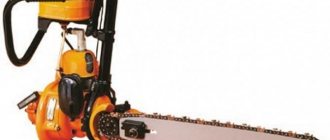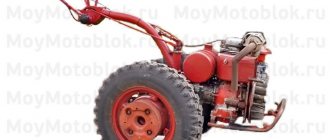Chainsaw delivery set
When purchasing a Husqvarna brand garden tool, the customer receives everything necessary to operate, maintain and repair a gasoline saw.
The model includes:
- branded tire and chain;
- protective plastic cover for the tire;
- additional spark plug;
- chain lubrication oil;
- set of keys for assembly;
- user manual.
For an additional fee, the manufacturer can include Husqvarna branded oil for 2-stroke engines, as well as a carrying bag made of thick, waterproof material, in the market supply of the chainsaw. Various attachments that increase the functionality of garden tools on the farm are ordered by the buyer separately.
Why is primary adjustment needed?
During the first hours of operation, the 2-stroke chainsaw engine requires running-in, on which the quality of its further operation depends. During the running-in process, the carburetor is initially adjusted - the optimal parameters for preparing and supplying the fuel mixture are established.
Initial running-in of the chainsaw: working with thin material
Most modern chainsaws are sold adjusted. However, it doesn’t hurt to check the quality of the factory settings - in the end, it’s you who will have to work with the tool.
When starting up for the first time, the chainsaw should operate in a gentle mode. Therefore, for several hours after start, it is recommended not to overload the engine and cut only small branches and trunks up to 10 cm thick.
Simple rules will help you insure against malfunctions of the chainsaw carburetor:
- Always mix gasoline and oil according to the manufacturer's instructions.
Proportions of the fuel mixture for a chainsaw engine
The chainsaw must start correctly, ensure a stable rotation speed of the sprocket and a smooth increase/decrease in power. There should be no extraneous knocks, pops or noises when the engine is running.
Professional hand chainsaw at work
The main thing during the initial running-in of the tool is to ensure that the fuel consumption corresponds to the power used, i.e. in practice, the saw should not go out, “sneeze”, smoke or run jerkily.
Husqvarna 137 chainsaw design - features and advantages
One of the main reasons for the popularity of the model from the Swedish manufacturer is the presence of high-quality components in its design. The Husqvarna 137 chainsaw consists of the following parts:
- Comfortable rubberized handles in the front and rear, as well as a starter cable handle;
- Durable starter, cylinder and clutch covers;
- Chain brake handles;
- Two tanks - for the fuel mixture and oil for chain lubrication;
- Levers for changing position and completely blocking the throttle valve;
- Ignition buttons:
- Silencer;
- Durable branded tire with drive sprocket:
- Chain and hex screw used to adjust its tension;
- Protective shield.
Under the durable body of the Husqvarna 137 chainsaw there is a 2-stroke engine, a fuel system with a carburetor and a reliable ignition system.
Advantages and disadvantages of the Walbro HD 6B carburetor
Undoubtedly, this carburetor has many advantages. Here are some of them:
- High-quality assembly of the carburetor and its high reliability. With proper and timely carburetor care, your chainsaw can serve you for many years. Numerous reviews on the Internet only confirm this.
- Convenient carburetor design. The membrane in the pulse chamber allows you to pump fuel when working in any position of the chainsaw, be it horizontal, vertical or side cutting. This is very convenient, unlike chainsaws with float-type carburetors, where fuel enters the carburetor by gravity and when cutting sideways the saw simply stalls.
Of the minuses, I would like to note the absence of a primer on the carburetor or a heating system for it. In Russia, it is often necessary to operate a saw in the winter season. In severe frosts, starting problems sometimes occur.
When choosing a carburetor, there is a chance of running into a fake. To avoid buying a counterfeit, before purchasing, watch the following video, which shows in detail what the factory packaging and the Zama carburetor itself for the Husqvarna 365 chainsaw look like.
About the manufacturer Husqvarna
The company called Husqvarna was founded in 1687. Husqvarna is a market leader in industrial and gardening equipment. Part of a Swedish concern that unites several companies. Producing various types of equipment, ranging from compact sewing machines to impressive ATVs.
Husqvarna offers its customers the most expanded range of specialized machinery and equipment. In recent years, the company has increased the number of patented innovations. Husqvarna is firmly committed to progress.
The products of this brand transform hard work (see how to cut down a tree with a chainsaw) into a simple task that does not harm either humans or the environment.
The Husqvarna 137 chainsaw belongs to the equipment produced under the Forestry Professionals category. Along with this model, the manufacturer also produces universal professional chainsaws, blowers and pole saws. All manufactured equipment is compact in size and easy to operate. All Husqvarna chainsaws are distinguished by three features - the ability to absorb excessive vibrations, an improved air filtration system, and high power.
Advantages
- combined lever for controlling a chainsaw - 3 functions are combined in one switch - starting, stopping the engine and adjusting the throttle to reduce the likelihood of filling the spark plug;
- Air Injection technology – the air is purified before passing through the air filter;
- X-Torq® is an innovative complex that allows you to reduce gasoline consumption and the production of toxic gases;
- LowVib functionality - due to steel dampers located between the motor and the handles, the operator is practically exposed to the negative effects of vibration;
- manual primer for winter operating conditions;
- emergency chain brake – activated manually and automatically for safe cutting;
- steel guide for durable service;
- chain for Husqvarna 236 chainsaw with standard pitch, easy to replace and tension;
- manual pump for supplying lubricant - prevents premature wear of the rubbing teeth of the saw set, covers the saw surface more effectively and can be adjusted manually;
- ergonomic body made of high-strength plastic;
- comfortable handles to grip;
- maintainability - original Husqvarna spare parts can extend the life of a chainsaw in case of almost any breakdown.
Instructions for setting up and adjusting yourself
Before moving on to setting up the Husqvarna 137 chainsaw, it is necessary to install it. Before starting work, you need to study the structure of the Husqvarna 137 chainsaw.
Be sure to wear gloves for protection. They are not included in the package, so you need to take care of purchasing them in advance. First you need to install the saw comb and secure it with two screws. If chains and bars are not installed, they should also be put in their place. To do this, you need to remove the cover and the nuts securing it. If there is a shipping pad on the chain, it must be removed.
Adjust the chain tension using the adjusting screw
It is important that the gripper can fit into the hole in the tire. To advance the grip, you need to turn the adjusting screw counterclockwise.
This way you can achieve the correct grip position. Next you need to prepare the circuit for installation. To do this, its correct position is selected. A sprocket is placed on the chain, which is located behind the clutch drum. The chain is passed between the teeth of the sprocket. The upper part of the guide bar must be moved into the groove of the guide bar that surrounds it.
Hold the guide bar relative to the chainsaw body to install the clutch cover.
The adjusting nuts are then inserted and tightened by hand. Once the chains have been fully adjusted, they can be fully tightened. You can find out how to adjust the carburetor in the instructions attached to this saw model. Tuning a Husqvarna 137 carburetor usually does not cause any problems.
When the installation is completed, you can proceed to setting up the Husqvarna 137 chainsaw.
- First you need to set the saw switch to the “On” position.
- Then pull the idle air damper lever all the way.
- Pull the starter cord with a sharp movement of your hand (but no more than ten times).
If the sound of the engine is heard before you have completed the 10th dash, you can move on to the next step.
Next, you need to move the lever to switch modes to the “HalfChoke” position. This will mean that the air damper will be half closed. Next, you need to jerk the starter cord until the engine starts. After starting the engine, you need to let it run for about five seconds. The engine starter must then be pressed and released to return the engine to idle speed.
To start and configure an already warmed-up engine, you need to:
- Set the saw switch to the “On” position.
- Direct the mode change knob towards o.
- With your right hand you need to pull the cord until the engine starts running.
- Press the engine starter until it returns to idle speed.
Watch the video for the disassembly and assembly process:
The principle of operation of a chainsaw carburetor
Before you adjust the carburetor on a chainsaw, you need to understand the principle by which it works.
- When the engine starts, the air damper located at the bottom of the housing opens.
- A vacuum is created in the air channel and float chamber caused by the stroke of the piston, as a result of which an air flow is sucked through the diffuser.
- The intensity of the air flow suction is regulated by the position of the air damper.
- Gasoline enters the float chamber through the inlet fitting from the gas tank.
- The speed of passage of gasoline from the chamber to the diffuser is controlled by means of jets.
- In the diffuser, gasoline is mixed with air.
- The prepared air-fuel mixture enters the intake channels, from where it is directed into the working combustion chamber of the cylinder.
Safety precautions for operating the Husqvarna device
Due to the fact that the Husqvarna 137 is a high-speed cutting tool, it is necessary to adhere to certain safety rules.
To avoid an accident, please read these instructions carefully.
The spark plug wire must be disconnected during transportation, cleaning
It is important to ensure that it does not come into contact with the spark plug to avoid the circuit suddenly turning on
When working with a saw, you must wear protective clothing: shoes with non-slip soles with steel inserts, special gloves (not included in the delivery package), a mask or safety glasses (anti-fog). Hair should be pulled back above the shoulders. If you regularly use a chainsaw, you should periodically have your hearing checked by a specialist. Chainsaws should only be used by adults. Do not place body parts under the saw while the motor is running. While the saw is operating, the presence of children and animals must be limited to at least ten meters. Do not use a chain saw while under the influence of alcohol, or when you are upset, depressed or tired. Do not start work until you are wearing protective clothing and your work area has been equipped. You should only work with the saw in a well-ventilated place. When you cut down a branch, be prepared to jump back the moment you finish the job so that you do not get hit by the felled tree limb. The saw can only be laid on the surface after it has been turned off. Before turning on the saw, make sure that the chain cannot come into contact with anything during operation. Maintenance of your chainsaw should only be carried out by a specialist. The saw handle should be clean and not stained with machine oil. The oil and fuel reservoir caps must always be tightly closed. Only accessories from . Do not smoke while refueling. You need to refuel the saw on bare ground in the open air. This is not allowed indoors. Before starting the chainsaw engine, you must move ten meters away from the place where the refueling took place. Be sure to let the saw cool before refueling. If the moving chain touches any object, a kickback may occur - rapid movement of the device down and up. This may result in complete loss of control of the chainsaw and further serious injury.
Therefore, never try to rotate the saw when removing it from the lower cut, and also do not try to cut several logs at the same time.
Never cut with just the tip of the chainsaw. Use guide bars to help mitigate kickback.
“Husqvarna 137” is an indispensable assistant on a country plot or dacha. It has a modern design, high power, compact dimensions and low fuel consumption. This is perhaps one of the best amateur chainsaws. With proper operation and compliance with all safety regulations, it will serve its owner faithfully for decades. Read about possible malfunctions of the Husqvarna 137 chainsaw in our other article.
Problems with the fuel supply system
If the tool does not work, this may be due to the fact that fuel is not entering the cylinder. First of all, you need to check the fuel filter for contamination levels. To check this, you need to remove the fuel hose and check how fast the fuel flows.
If it is supplied under low pressure, then the problem lies in the filter.
In this case, you need to clean the filter. It is taken directly through the tank. The filter is cleaned and installed back. It is washed under running clean water.
After this, the filter is dried and carefully installed back. To prevent this problem from occurring in the future, it is necessary to periodically clean the filter.
If cleaning the filter does not give a positive result, then you should pay attention to the breather. A clogged hole in this hole causes insufficient air to enter the carburetor.
Expert advice: when troubleshooting such faults, you must use the instructions, this will prevent more serious breakdowns from occurring.
Adjusting the Husqvarna 142 carburetor
The carburetor of the 142 Husqvarna chainsaw is adjusted in several directions. Since the carburetor is responsible for mixing fuel with air in optimal proportions, one of the areas of adjustment will be the quality of the fuel mixture. The second direction of adjusting the chainsaw carburetor is associated with a decrease in the supplied fuel. The need for such adjustment is often due to incomplete combustion of the fuel and its release in the form of thick smoke.
Tools needed for adjustment work:
- Special screwdrivers for adjusting screws (purchased in specialized stores);
- Tachometer (some experienced chainsaw owners, in the absence of a tachometer, rely on hearing);
- Crosshead screwdriver;
- Compressor with blow gun.
Before starting setup work, it would be good to diagnose the chainsaw. It is worth making sure that the filter is in good condition and does not require replacement. Check for fuel supply obstruction. Be sure to remove dirt and dust from the components and the chainsaw itself. Since adjustment will require disassembling the unit, it is necessary to remember the correct location of spare parts. The chainsaw operating instructions, which contain an assembly diagram, will help you avoid getting confused. But even if for some reason there is no diagram, you can film everything on your mobile phone camera.
So, we have the tools, the diagnostics have been carried out, let's start making adjustments.
Screw adjustment (L)
We begin setting up the Husqvarna 142 carburetor by setting the factory settings with the saw turned off. After this, start the saw and let it run for a few minutes. Next, turn the screw (L) in the direction of the clock hand until you find the moment where the engine gains the highest speed. Having caught the right moment, turn the screw a quarter turn in the opposite direction. If the chain moves, the screw (T) will need to be adjusted.
Screw adjustment (H)
Adjustment of the screw is done in the first 10 seconds of operating the engine at maximum speed. How to adjust the carburetor on a Husqvarna 142 chainsaw at the highest speeds. To set up, just turn the screw (H) a quarter turn clockwise. Having noticed that the maximum load has not been achieved, we repeat all the manipulations. To complete the adjustment, you will need a tachometer, which must be connected to the switched on saw. If insufficient adjustment is made, the running engine will make unnatural squealing sounds. In a situation where the adjustment is overdone, a large amount of smoke appears.
Screw adjustment (T)
Working with this screw is very simple. It consists of turning the screw in the direction of movement of the clock hand. The screw should be turned exactly until the second when the chain begins to move. As soon as the movement begins, the screw turns in the opposite direction until the chain stops moving.
The entire carburetor adjustment process must be performed in the same sequence as described above.
To evaluate whether the carburetor adjustment on the Husqvarna 142 was performed correctly, look at how the chainsaw operates after adjustment. The tool shows stable operation both at low and high speeds. The speed should be easy to pick up. The motor operates without unnecessary alien noise and does not stall. Check engine operation. It's easy to do. Press the gas trigger sharply several times
Please note that when you press the trigger, the speed should increase very quickly, and when released, it should decrease. If everything goes exactly like this, then the setup was completed without errors
In addition to the need to adjust the carburetor if there is some malfunction of the tool, there are two more cases in which adjustment work is simply necessary. The first case is changing the fuel mixture used, and the second is before preparing for the summer season after wintering and vice versa. The owner of a power tool always has the choice to act independently or contact a service center to have this work carried out by specialists. You should not start setting up a carburetor without having any similar experience.
Unfortunately, adjusting the carburetor does not always help solve problems. Often, the cause of unsatisfactory performance of a tool can be the breakdown of one or another part. If you cannot find the cause of a particular malfunction on your own, then it is better to show your tool to professionals in a specialized service center. The work of specially trained people will cost much less than breaking a power tool with your own hands.
Typical faults and solutions
Even such a high-quality tool as the Husqvarna 137 chainsaw sometimes fails. It’s quite easy to figure out the breakdown and fix it yourself. Below we will look at the most common problems with chainsaws and how to repair them yourself.
How to adjust the carburetor of a Husqvarna 137 chainsaw?
Repairing the carburetor of the Husqvarna 137 chainsaw in most cases involves tuning it. For this purpose, the saw design provides 3 adjusting screws:
- Screw “T” allows you to adjust the operation of the Husqvarna 137 saw at idle speed;
- Screw “H” is intended for quick adjustment of the saw in order to operate it at high speeds;
- Screw "L" is used to adjust the tool motor at low speed.
The carburetor is adjusted in the following order:
- To begin, start the chainsaw and rotate the screw marked “L” clockwise until the saw operates at maximum speed;
- Immediately after this, turn the same screw exactly ¼ turn in the opposite direction. If the saw chain rotates, turn the screw “T” until it stops completely;
- Let the engine run for about 20 seconds, pull the trigger at full throttle and begin turning the screw “H” in a strictly counterclockwise direction, making a quarter turn;
- Wait at least 10 more seconds - if the engine of your tool starts to work like a 4-stroke engine, then you have adjusted the chainsaw carburetor correctly.
At the end, you will need to adjust the operation of the Husqvarna 137 saw at idle speed. To do this, start the engine and turn the screw “T” until the chain begins to rotate. After this, the screw should be turned in the opposite direction until the chain stops.
How to remove the carburetor and whether it needs to be done before tuning
In the event that the chainsaw does not develop speed or, on the contrary, operates at too high speeds, the carburetor can be adjusted without removing it.
See » Technical characteristics and carburetor adjustment of the semi-professional chainsaw Stihl MS-230
But if the chainsaw does not start, the speed hangs at the same level or it works unstably. Adjusting the chainsaw carburetor will not change the situation. It must be removed for cleaning or replacing parts. You must proceed in the following order:
- After unscrewing the retaining fasteners, remove the upper casing of the saw.
- We remove the gasket and part of the air filter by unscrewing the bolts or snapping off the fasteners.
- There is a fuel hose on the right side of the carburetor. We remove it together with the air damper control rod.
- Remove the carburetor from the mounts holding it.
Disassembling the carburetor is carried out in accordance with the instructions supplied with the kit.
When disassembling, take special care to place the parts on a previously prepared cloth. Due to its small dimensions, there is a risk of losing components during disassembly and washing
All parts obtained in this way are washed in a special liquid, dried and wiped with a lint-free cloth.
Channels, tubes and jets are purged with compressed air, if possible, after having previously washed them in an ultrasonic bath.
Repair features
Some problems with the Husqvarna 137 chainsaw can be fixed on your own. The service center is contacted only in cases where parts receive mechanical damage or wear out to a critical condition.
Important Do-it-yourself modifications to the MTZ-82 and MTZ-132N: alteration of the steering, engine, half-track, installation of an axle
To carry out minor repairs or replace worn parts, use the repair tools that come with the product.
Work is carried out according to the table of possible breakdowns that may occur during operation.
So, if the saw does not start, the reason must be sought in the fuel supply system. When the tool stalls during operation, the repair of the Husqvarna 137 chainsaw may be limited to cleaning the muffler from carbon deposits.
How to adjust the carburetor
Primary adjustment of the carburetor is carried out at the manufacturer to standard fuel parameters based on operation in summer conditions. Changes in settings occur due to vibration during sawing wood or due to the use of a low-quality fuel mixture. Adjusting the chainsaw carburetor is performed in cases where the engine is unstable, does not start or stalls under load.
To repair a carburetor with your own hands, you need to have the following tools:
- screwdriver;
- wrench;
- thin wire.
Restoring the functionality of the product is carried out in the following ways:
- Cleaning clogged channels with wire.
- Adjusting the tension of the gas damper drive cable.
- Removing the faulty membrane and installing a new part.
- Sealing connections.
- Replacing the gasket.
After eliminating the malfunction, the device is fine-tuned by rotating the bolts L (crankshaft speed), T (idle speed) and H (fuel supply volume).
How to disassemble and reassemble a chainsaw
Disassembly of the product is carried out when:
- seasonal service;
- repair;
- planned replacement of worn parts and mechanisms.
The product is disassembled in the following sequence:
- Remove the handles.
- Loosen the housing bolts and remove the covers.
- Dismantle the tire and remove the chainsaw sprocket.
- Disconnect the starter.
- Unscrew the flywheel.
- Remove the clutch and oil pump drive.
- Disconnect the carburetor muffler and ignition coil.
- Disassemble the engine.
The unit is assembled in the reverse order.
How to install the repair kit?
If the problem affects the carburetor nozzle, you can try to fix the serious problem yourself. However, the manufacturer recommends dealing with this problem only by replacing the unit.
To remove the carburetor, you need to completely clear the saw of sawdust and shavings. To do this, you need to use a compressor and a compressed air gun. Next, unscrew the filter cap and remove the filter element. After this, all drives and throttle linkages are disconnected from the Husqvarna carburetor. Now you can remove the carburetor from the saw.
Next, you need to completely disassemble the carburetor and replace all the elements that the repair kit offers. Namely, spare parts and gaskets. This will save you from breakdowns in the future.
Now you know how to adjust the carburetor of the famous Husqvarna 137 chainsaw.
Basic carburetor malfunctions on a chainsaw
It should be understood that the dimensions of all holes are very small. Even the smallest contamination can block the flow of air or fuel, which is why filter elements are installed at the inlet ports. Unfortunately, they do not always cope with the task. The following signs indicate a malfunction of the chainsaw carburetor:
- High gasoline consumption and thick smoke from the exhaust;
- The engine “does not pull”;
- Floating speed;
- The engine starts, but stalls immediately or after a few seconds;
- The engine does not start at all.
- Chainsaw shoots at carburetor
All these malfunctions are a sign that the carburetor on the chainsaw is not adjusted correctly or that it is dirty. This implies the need for adjustment, cleaning or repair. Let's look at how to do this below.
Model specifications
Among the main advantages of the Husqvarna chainsaw in the 137th modification, one should highlight its solid factory parameters.
These include:
- engine power – 2.18/1.6 kW;
- idle speed/maximum engine speed – 3000/12000 rpm;
- possible length of the installed tire is 33–38 cm;
- chain link thickness – 1.3 mm;
- weight with full tanks of fuel and chain oil – 4.7 kg.
This Husqvarna chainsaw differs from other popular market analogues in its relatively low fuel consumption. During operation under average loads, this parameter is 300 ml of fuel mixture per hour. As the engine speed of the chainsaw increases, this indicator practically does not change.
Evaluation parameters and scope of application
The tool's high center of gravity, narrow configuration and flat body bottom contribute to the slow accumulation of fatigue. The user rating obtained during the survey is evidence of the high reliability, power and versatility of the model.
For a 10-point scale, the average was 8.3.
The characteristics of the tool determine its use in a wide range of household works, including:
- firewood preparation;
- preparation for installation of construction timber;
- formation of crowns of ornamental and fruit trees;
- independent production of wooden items for interior design and landscape design.
The saw successfully copes with single-pass, standard, longitudinal and diagonal sawing of hardwood with a diameter of up to 30 cm. The compact design makes it possible to work in hard-to-reach places, which is especially valued in construction technologies.
Chainsaw delivery set
When purchasing a Husqvarna brand garden tool, the customer receives everything necessary to operate, maintain and repair a gasoline saw.
The model includes:
- branded tire and chain;
- protective plastic cover for the tire;
- additional spark plug;
- chain lubrication oil;
- set of keys for assembly;
- user manual.
For an additional fee, the manufacturer can include Husqvarna branded oil for 2-stroke engines, as well as a carrying bag made of thick, waterproof material, in the market supply of the chainsaw. Various attachments that increase the functionality of garden tools on the farm are ordered by the buyer separately.
Operating principle
The purpose of the carburetor is to prepare the working mixture for supplying it to the engine cylinders. This mixture is gasoline and air in the proportions required for engine operation. If this ratio is violated, the engine will not operate smoothly. When the mixture has a lot of gasoline, then in layman's terminology it is called saturated, and if, on the contrary, there is little, then it is lean. But in any case, a failure in the proportions of the working mixture will have a bad effect on performance.
Different models of chainsaws may have different carburetor designs, but according to the principle of operation they are all identical. Air moves through a special channel at a speed that can be adjusted by closing or opening the damper. Gasoline, in turn, enters the carburetor through jets and mixes with air there, creating a special mixture that enters the engine.
The pressure in the float compartment of the carburetor, where gasoline is present before mixing, is close to atmospheric. When the damper is opened, there is more air, as well as gasoline, due to which the engine speed increases. This creates a vacuum in the air channel and gasoline is drawn into the air flow. This is the principle of operation of a carburetor .
In order for the chainsaw to operate smoothly and efficiently, and also without high fuel consumption, its carburetor must be adjusted accordingly. Before such work, you must first check the air and gasoline filters. If dirt is found on them, they should be replaced.
Setting up a chainsaw for most models is usually done using three screws - high and low speed and idle speed.
The following signs should indicate correct configuration:
- The chain should not move at idle.
- The motor runs smoothly.
- There should also be no interruptions in work at start-up.
Repairing a chainsaw carburetor with your own hands must be done very carefully, because any mistake made can lead to serious consequences, even to the point of complete engine failure. If you do not have sufficient experience, then it is better to seek the help of a specialist .
About the carburetor design
The carburetor serves to mix the flammable mixture with air while maintaining predetermined proportions. When is it necessary to adjust a chainsaw carburetor? Husqvarna 137. If precise doses are not followed, the proper operation of the engine is at risk. Adjusting the carburetor of a Husqvarna 137, like a Husqvarna 240 or 260, will also save your chainsaw. When a huge amount of air enters during mixing of the components, but there is not enough fuel, then such a mixture is considered “lean”.
Oversaturation should not be allowed, because with a larger amount of fuel compared to air, malfunctions or engine wear are also likely. Carburetor adjustment is needed not only before initial use, but also when any differences in its operation are detected. Before working with a chainsaw, do not forget to run it in.
Carburetor components
The carburetor design contains a standard set of parts, but may vary slightly depending on the manufacturer. Components:
- The basis. This is a special tube that is visually similar to an aerodynamic design. Air passes through it. In the transverse direction, a damper is located in the middle of the pipe. Its position can be changed. The more it is extended into the passage, the less air enters the engine.
- Diffuser. This is the constricted part of the tube. With its help, the air supply speed increases precisely in the segment from which the fuel comes out.
- Channels for fuel supply. The fuel mixture is contained in the float chamber, then passes into the nozzle, from which it flows into the atomizer.
- Float chamber. Adjusting the Husqvarna 236 carburetor. Do-it-yourself carburetor adjustment;. It is a separate structural element, reminiscent of the shape of a tank. Designed to constantly maintain the optimal level of fuel fluid before entering the channel from which air enters.
Don't know which chainsaw to choose? Read our article.
Are you looking for cheaper models, but reliable and time-tested? Pay attention to Russian-made chainsaws.
Or explore foreign chainsaw manufacturers such as STIHL.
Safe carburetor adjustment
Correct, economical operation of the saw generally depends on the settings of its parameters. Adjusting the chainsaw is based on three main elements for proper engine starting:
- correct compression;
- correct spark;
- the right fuel.
It is also useful to know 3 common problems with chainsaws:
- Spark plugs, inexpensive and easy to replace.
- Fuel-powered mowing lines, inexpensive and not too difficult to replace.
- Carburetors, only adjustment or complete replacement is possible, the cost of a new one, made in China, is approximately 10 US dollars.
Gas line can be tested using a sensor similar to the one used to test car tires. It has a conical rubber tip that presses against the opening of the Spark Plug. By pulling the starter rope, you can obtain data from the device. Then check the wires that go to the ON - OFF switch. They should be tight and not touch the metal of the engine.
Chainsaw carburetors can have leaking gaskets, warped valves, and bad fuel pump diaphragms that need to be replaced with a factory repair kit.
Basic setup of Husqvarna's 236
It is necessary to regularly tune your Husqvarna to ensure good performance and prevent damage caused by an irregular engine. The three screws on the Husqvarna 236, 361 carburetor are used to fine tune the engine to ensure smooth operation.
Basic setup requirements:
- The air filter must be clean. If the carburetor has a dirty air filter, the saw will produce a fuel mixture that is too lean. This could cause serious engine damage.
- The chain should not be tensioned more than 0.2 inches.
- Replacing the entire H-needle or desired carburetor: Carefully screw the new H-needle into the bottom and turn it counterclockwise.
- Start the engine. If necessary, adjust the idle speed using the T-screw.
About the carburetor design
The carburetor serves to mix the flammable mixture with air while maintaining predetermined proportions. When is it necessary to adjust a chainsaw carburetor? Husqvarna 137. If precise doses are not followed, the proper operation of the engine is at risk. Adjusting the carburetor of a Husqvarna 137, like a Husqvarna 240 or 260, will also save your chainsaw. When a huge amount of air enters during mixing of the components, but there is not enough fuel, then such a mixture is considered “lean”.
Oversaturation should not be allowed, because with a larger amount of fuel compared to air, malfunctions or engine wear are also likely. Carburetor adjustment is needed not only before initial use, but also when any differences in its operation are detected. Before working with a chainsaw, do not forget to run it in.
Carburetor components
The carburetor design contains a standard set of parts, but may vary slightly depending on the manufacturer. Components:
- The basis. This is a special tube that is visually similar to an aerodynamic design. Air passes through it. In the transverse direction, a damper is located in the middle of the pipe. Its position can be changed. The more it is extended into the passage, the less air enters the engine.
- Diffuser. This is the constricted part of the tube. With its help, the air supply speed increases precisely in the segment from which the fuel comes out.
- Channels for fuel supply. The fuel mixture is contained in the float chamber, then passes into the nozzle, from which it flows into the atomizer.
- Float chamber. Adjusting the Husqvarna 236 carburetor. Do-it-yourself carburetor adjustment;. It is a separate structural element, reminiscent of the shape of a tank. Designed to constantly maintain the optimal level of fuel fluid before entering the channel from which air enters.
READ How to Disassemble a Husqvarna 137 Chainsaw
Don't know which chainsaw to choose? Read our article.
Are you looking for cheaper models, but reliable and time-tested? Pay attention to Russian-made chainsaws.
Or explore foreign chainsaw manufacturers such as STIHL.
Design of a simple chainsaw
The first U.S. patent, 80,476, for an "endless chain saw" was granted to Samuel J. Bens of San Francisco on January 17, 1905. It was a huge static wood sawing machine. Basically, Bence developed the operating principle of the saw, but the new invention did not indicate its power source. Any external source - steam or gas engine - was attached to the saw. Only 16 years later, in 1921, he filed another patent No. 1617565 for a portable chain saw with a self-contained power source.
The structure and internal structure of the chainsaw has not changed much since then. It has two main parts: a cutting wheel built into a chain wrapped around a long metal guide rod, and a small single-cylinder gasoline engine (sometimes an electric motor powered by an electrical outlet or battery). The chain is a bit like a bicycle chain, running around the sprockets - the gears designed to turn the chain - only with 30 sharp teeth (made from a hardened steel alloy) spaced at intervals.
The principle of operation of the saw is that it converts the chemical energy of gasoline into mechanical energy, which drives the chain. Typically the gasoline tank holds only 0.5 liters. Gasoline is fed through the carburetor , where it is mixed with air. The air-gasoline mixture goes into a cylinder, which works in the same way as in a car engine, but with a simple two-stroke cycle instead of the more complex four-stroke cycle used in a car.
Inside the cylinder, the air-fuel mixture is ignited by a spark plug, the gasoline releases its energy and pushes the piston forward. The piston in a chainsaw usually has a diameter of about 45 mm and a stroke of about 33 mm. The crank mechanism converts the reciprocating motion of the piston to the rotational motion of the sprocket on which the chain is mounted.
A centrifugal clutch connects the motor and the chain. The mechanisms carry power from the clutch to the sprocket, which holds the chain. The chain rotates around the edge of a long plate called a guide bar.
